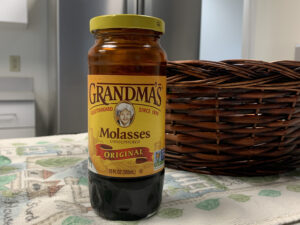Molasses or Malarkey?
go.ncsu.edu/readext?979207
en Español / em Português
El inglés es el idioma de control de esta página. En la medida en que haya algún conflicto entre la traducción al inglés y la traducción, el inglés prevalece.
Al hacer clic en el enlace de traducción se activa un servicio de traducción gratuito para convertir la página al español. Al igual que con cualquier traducción por Internet, la conversión no es sensible al contexto y puede que no traduzca el texto en su significado original. NC State Extension no garantiza la exactitud del texto traducido. Por favor, tenga en cuenta que algunas aplicaciones y/o servicios pueden no funcionar como se espera cuando se traducen.
Português
Inglês é o idioma de controle desta página. Na medida que haja algum conflito entre o texto original em Inglês e a tradução, o Inglês prevalece.
Ao clicar no link de tradução, um serviço gratuito de tradução será ativado para converter a página para o Português. Como em qualquer tradução pela internet, a conversão não é sensivel ao contexto e pode não ocorrer a tradução para o significado orginal. O serviço de Extensão da Carolina do Norte (NC State Extension) não garante a exatidão do texto traduzido. Por favor, observe que algumas funções ou serviços podem não funcionar como esperado após a tradução.
English
English is the controlling language of this page. To the extent there is any conflict between the English text and the translation, English controls.
Clicking on the translation link activates a free translation service to convert the page to Spanish. As with any Internet translation, the conversion is not context-sensitive and may not translate the text to its original meaning. NC State Extension does not guarantee the accuracy of the translated text. Please note that some applications and/or services may not function as expected when translated.
Collapse ▲Sometimes I get the most interesting calls! Questions from plant, weed, and insect identification to various products to be used in helping us grow our plants. This week I got a question about using molasses as fertilizer. Sometimes we don’t like to ask questions because we think they may be silly or perhaps we are embarrassed but we still want to know the answer. In my opinion, there is no silly question! I learned more about molasses than I ever thought I would know this week.
I learned about how molasses is made. Did you know it is a byproduct of processing sugarcane or sugar beets? Sugarcane molasses is the major food molasses today, processed especially for that industry. Both sugarcane and sugar beet molasses are used in the animal feed industry and as fermentation sources for various alcohols. What about sorghum molasses? Sorghum syrup was known colloquially all over the South as “sorghum molasses” or just “molasses”. In the 1800’s into the middle part of the 20th century, molasses was used in place of much more expensive sugar. It was used on many products such as collards, grits, cornbread, pie, and even popcorn. Then, just like today, it was used around the world to distill into Rum. If you are ever over at the Outer Banks, check out Outer Banks Distilling, makers of Kill Devil Hills Rum. They offer tours of the distillery and tastings where you can learn all about the process and history of molasses and rum.

Molasses
There are different grades of molasses depending upon how refined it is as well. Blackstrap molasses is the byproduct from the sugar factory or raw sugar refinery. This isn’t your Grandma’s Molasses! It is a very dark, highly viscous liquid that remains after no more sugar can economically be extracted. This is the product we are concerned with in our venture to use molasses as fertilizer. There is “Sulfured Molasses” and “Unsulfured Molasses”. The sulfured molasses has had sulfur dioxide added during the refining process. Unsulfured molasses is much more common and contains less sulfur.
As important of an agricultural product as molasses has been to the history, economy, and taste buds of North Carolina, this question covered another possible use of this product, fertilizer. There are a multitude of ways this product is being marketed. There is a liquid “Recipe” that consists of molasses and organic fertilizers. Keywords – Organic Fertilizers! This same concoction is marketed for use as a foliar fertilizer. The way that foliar fertilizers work is that they are taken into the leaf through tiny openings called Stomata. Stomata are the plant’s mechanism for gas exchange, water, carbon dioxide, and oxygen to move into and out of the leaf. The other means to enter the plant is across the protective cuticle. This is not going to happen! There is no research-based information, that I can find, which supports the use of molasses, in any formulation, as a fertilizer.
Molasses is also being touted as a soil amendment. “Dry Molasses” is what is being used in this one. This product is made by spraying molasses onto corn meal or soybean meal, it is then dried and pelletized. While there are some benefits of supporting microbial activity with molasses-based products, there is still no research-based information that supports this claim.
Lastly, molasses is being touted as a fire ant killer or insecticide replacement. Linda Chalker-Scott of the University of Washington is the author of a blog called “The Garden Professors” in which she debunks horticultural myths. She has a great 3-part piece titled “Molasses Malarkey” where she discusses the insecticidal claims of one marketing advertisement. This is a great piece of reading that has practical information and a bit of horticultural humor!
If you are having trouble with growing in your home landscape, call the Extension office at (252)946-0111 or email Gene Fox at gene_fox@ncsu.edu. If you have a plant that you are unable to identify or would like to know more about the plants in your landscape, let’s talk! Like an old family doctor, I do house calls if we can’t figure out your problem!



